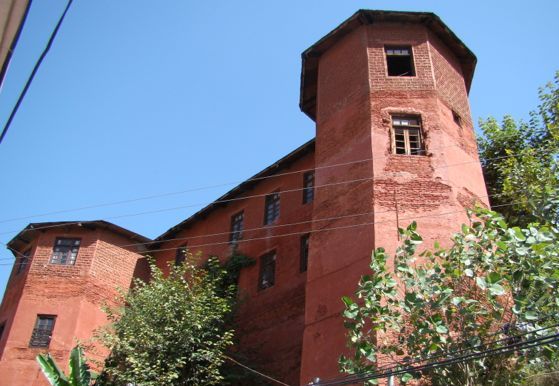
Rang Mahal, Chamba
Rang Mahal is one of the largest monuments located in Surara Mohalla of Chamba town. It has streets on three sides from east, west, and north, while on the fourth is the residence of wazirs of the former ruling family of Chamba.
The literal meaning of the Rang Mahal is ‘The Luxury Palace’. The architecture of this palace is based on Mughal architecture. It looks like a small fort.
This palace was founded by Raja Umed Singh (1748- 64) and completed the construction work by Raja Raj Singh (1764-94).
It is beautifully decorated with paintings of different themes like scenes from Ramayana, Bhagwat Puran, Durga Saptshati, and Lord Shiva – Parvati etc.
All the paintings were painted by Mian Tara Singh and his assistants. Rang Mahal catches very sight of visitors from a long distance. It has been tastefully decorated with finely carved wooden doors, windows, ceilings, galleries, and balconies.
It is surrounded by a thick population of Draubhi and Surara mohallas. It was made up of stones and Nanak Shahi red bricks. It is a five stories building. It has many big rooms, halls, waiting rooms, bedrooms, and big corridors and galleries. There is a square ground in the centre of the palace.
Many cultural programmes and parties were organized in this ground by the Rajas of Chamba. This palace had adequate water supply and also had a facility of toilet.
It was a favourite place of Rajas and Ranis of Chamba but it was neglected during the rule when Raja Shri Singh shifted to the newly built Akhand Chandi Palace. Only some elderly women besides a few concubines and main servants were left to stay in the old and deserted Rang Mahal.
After independence, the Rang Mahal has been thrown open to the general public. Now, these days Rang Mahal is used for the district level offices of employment exchange, language, arts and culture, handicraft and handlooms board, a centre of Chamba embroidery.
Most of the rooms are now used for workshops for making shoes, chappals, and Chamba rumals. All such Rang Mahal (Luxury Palaces) found in different state of India were built by the then ruling Chief‟s Chieftains, Rajas, Ranis, Nawabs and other affluent wells to do persons having a high degree of esthetic sense and cultural background for their pleasure, show, fun and frolics and revelry as well.
Strongly built with the masonry and woodworks in typical identical architecture, all such deluxe Palaces contain fine carving on stone and wood, mural paintings of exquisite workmanship on walls, ceilings, doors, corridors, windows, etc.
These Rang-Mahals with the passage of time, however, have lost their pristine, glory, grandeur-charm, and now present a dismal deserted look. But they do tell a tale of their past which was so rich and glorious and as such enjoys the status of a Heritage and buildings and attracting art historians, connoisseurs of arts and culture besides tourists in general.
Nearby such is the condition of all the Rang Mahals found in the length and breadth of the country and so is the Rang Mahal in Chamba town, the capital of erstwhile Chamba State (now a district) in Himachal Pradesh.
The Rang Mahal at present houses the district level offices of the employment exchange, Language, Arts and Culture, handicrafts and Handlooms Board, Centre of Chamba Embroidery and Woodworks, Leatherwork, and Hosiery. A branch post office is also presently in the Rang Mahal.
Evocative of the bygone era, the Chamba Rang Mahal has lost much of its charm, glory, grandeur, and romance as well. Keeping in view the historical, architectural and cultural importance of the grand building, various socio-cultural organizations of Chamba i.e., Sahitya Kala Parishad, Prabudhha Mandalam (Intellectual Forum) and Chamba Welfare Association have demanded that the heritage building of the Rang Mahal be converted into a Heritage Hotel where as many as 6 deluxe suites, about 10 semi-deluxe rooms, 4 big halls with spacious courtyards in the middle of the complex can be conveniently developed to cater to the needs and comforts of the Indian and foreign tourists visiting Chamba all the year-round.
The Chamba Chapter of Indian National Trust for Arts & Culture Heritage (INT ACH) demands setting up of a craft complex in the palace where master craft-persons of the district could open their workshops in metal-craft and stone crafts besides Chamba embroidery works.